 On Sunday, we had a truly beautiful winter day. Because the blizzard hit Boston on a weekend, the snowplows were not as active as they would have been during the working week. For the first half of Sunday, the entire neighborhood lay covered in a blanket of pristine white snow, and only around lunchtime did people begin emerging from their houses to reluctantly shovel their driveways.
On Sunday, we had a truly beautiful winter day. Because the blizzard hit Boston on a weekend, the snowplows were not as active as they would have been during the working week. For the first half of Sunday, the entire neighborhood lay covered in a blanket of pristine white snow, and only around lunchtime did people begin emerging from their houses to reluctantly shovel their driveways.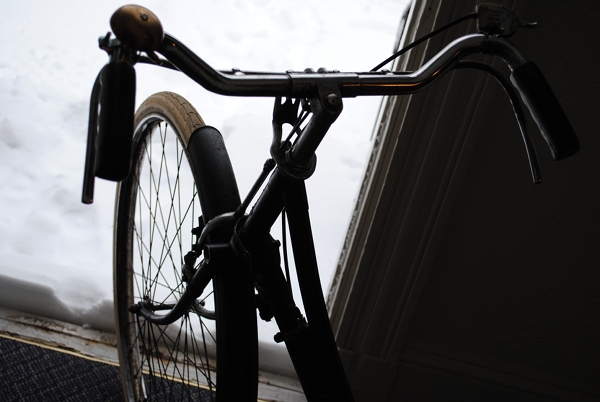 Despite being down with a minor cold, Velouria could not sit still in the blizzard. Stir-crazy in our small apartment and desperate to feel the fresh snow under her tires, she begged me to come out just for a bit, at least to give it a try. How could I resist her charms?
Despite being down with a minor cold, Velouria could not sit still in the blizzard. Stir-crazy in our small apartment and desperate to feel the fresh snow under her tires, she begged me to come out just for a bit, at least to give it a try. How could I resist her charms? She posed for me next to the fence while I photographed her this way and that. A kickstand was not necessary, because the foot-deep snow enveloped her wheels and functioned as a bicycle rack. With her black frame and cream tires, Velouria was stunning in the snow. The aesthetic experience of seeing her thus even made up for carrying her down the front stairs - which had been semi-visible when the Co-Habitant left for work several hours earlier, but were now completely buried in snow. With the bike in my arms, I slowly extended my toe and felt each step under the snow before proceeding onto it. With the 40lb DL-1 this was doable, but I would not have been able to execute the same maneuver with the heavier Pashley.
She posed for me next to the fence while I photographed her this way and that. A kickstand was not necessary, because the foot-deep snow enveloped her wheels and functioned as a bicycle rack. With her black frame and cream tires, Velouria was stunning in the snow. The aesthetic experience of seeing her thus even made up for carrying her down the front stairs - which had been semi-visible when the Co-Habitant left for work several hours earlier, but were now completely buried in snow. With the bike in my arms, I slowly extended my toe and felt each step under the snow before proceeding onto it. With the 40lb DL-1 this was doable, but I would not have been able to execute the same maneuver with the heavier Pashley.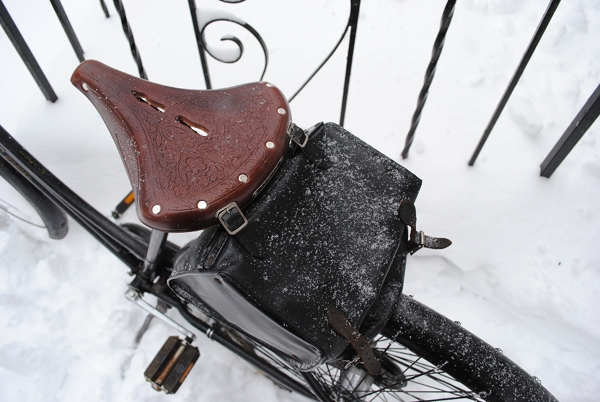 The snow was still falling as we prepared to head out, quickly covering the saddle with a thin layer of powder.
The snow was still falling as we prepared to head out, quickly covering the saddle with a thin layer of powder.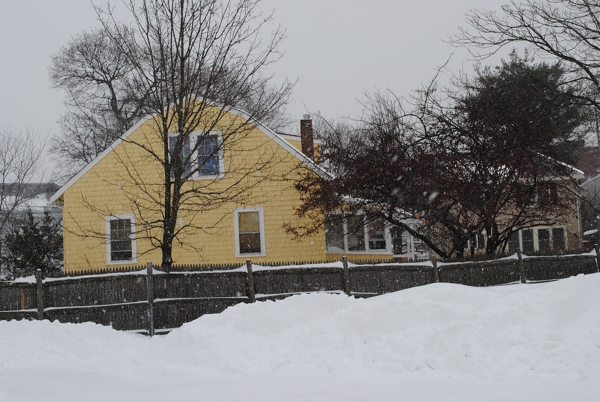 Upon Velouria's advice, the voyage I chose was an easy and safe one: a trip to a grocery store that is just a 6 minute walk (3 minute ride under normal conditions) from our house via a secret route through dead-end back streets. There would hardly be any cars there, and if I found myself unable to ride I could just walk the bicycle the rest of the way to the store and back.
Upon Velouria's advice, the voyage I chose was an easy and safe one: a trip to a grocery store that is just a 6 minute walk (3 minute ride under normal conditions) from our house via a secret route through dead-end back streets. There would hardly be any cars there, and if I found myself unable to ride I could just walk the bicycle the rest of the way to the store and back. I took my camera along and had grandiose plans to stop every so often and photograph Velouria against the backdrop of various winter scenes. However, the visibility was so poor and the snow so... snowy, that getting off the bicycle to pose it became the farthest thing from my mind once we were underway. Instead I offer you views of a few landmarks.
I took my camera along and had grandiose plans to stop every so often and photograph Velouria against the backdrop of various winter scenes. However, the visibility was so poor and the snow so... snowy, that getting off the bicycle to pose it became the farthest thing from my mind once we were underway. Instead I offer you views of a few landmarks. "No Outlet" - Hah! Perhaps not for cars, but for a bicycle the gaps between fences will do just fine.
"No Outlet" - Hah! Perhaps not for cars, but for a bicycle the gaps between fences will do just fine.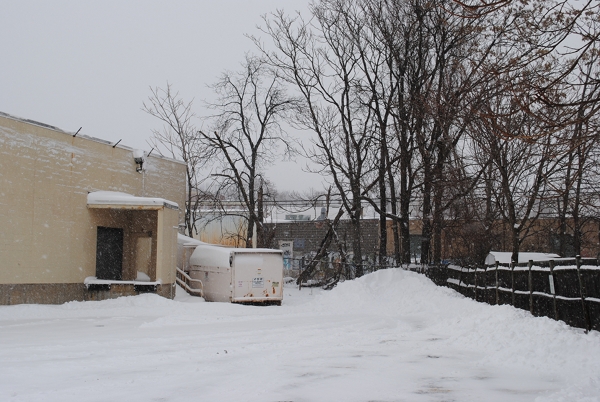 Arriving to the grocery store via the back parking lot.
Arriving to the grocery store via the back parking lot.At this point I will give you my ride report: Basically, my biggest problem was visibility, or rather, the lack thereof. These pictures do not really capture how difficult it was to see in front of me as I was cycling, but the falling snow obscured my vision completely. In these back alleys that was okay, but I cannot imagine cycling on real city roads in these conditions. As for the bicycle's behaviour... It was fine. Granted, I was so paranoid about falling, that I cycled very slowly and made ridiculously wide turns. Riding through the snow in this manner felt similar to cycling on the sandy fire trails on Cape Cod, only slower.
 I did not experience a sense of slipping on the snow while going straight or while making turns, but again, I was intentionally cycling very slowly. The tires on my DL-1 are the Schwalbe Delta Cruisers, 28" x 1 1/2". By the time I returned home from the grocery store (having purchased a bag of raw cranberries and some chocolate), the snow had made its way into every single crevice of the wheels, covering the spaces between the spokes and dress-guard cords.
I did not experience a sense of slipping on the snow while going straight or while making turns, but again, I was intentionally cycling very slowly. The tires on my DL-1 are the Schwalbe Delta Cruisers, 28" x 1 1/2". By the time I returned home from the grocery store (having purchased a bag of raw cranberries and some chocolate), the snow had made its way into every single crevice of the wheels, covering the spaces between the spokes and dress-guard cords.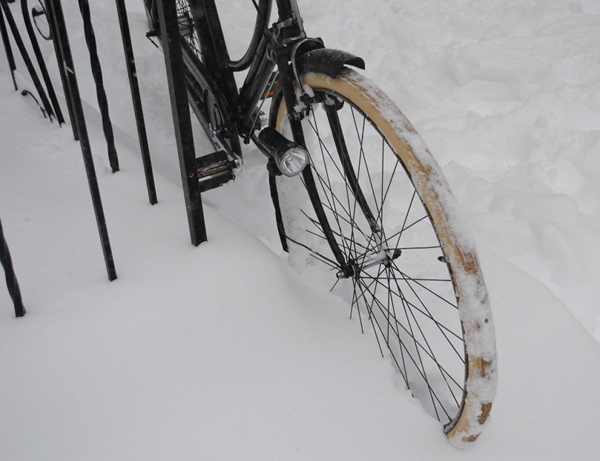 If you click to enlarge the picture above, you can see that the snow also made its way into the gaps around the brakes. This is a problem not just for bicycles with rod brakes, but for any bicycle with rim brakes. The snow lodges itself in between the rim of the wheel and the brake pad immediately, increasing stopping time considerably. Because I was cycling so slowly, this did not really matter; at that speed I could stop the bicycle by merely putting a foot down. But if you plan to cycle with anything resembling normal speed, I think drum or disk brakes are the only solutions that will provide adequate stopping power.
If you click to enlarge the picture above, you can see that the snow also made its way into the gaps around the brakes. This is a problem not just for bicycles with rod brakes, but for any bicycle with rim brakes. The snow lodges itself in between the rim of the wheel and the brake pad immediately, increasing stopping time considerably. Because I was cycling so slowly, this did not really matter; at that speed I could stop the bicycle by merely putting a foot down. But if you plan to cycle with anything resembling normal speed, I think drum or disk brakes are the only solutions that will provide adequate stopping power.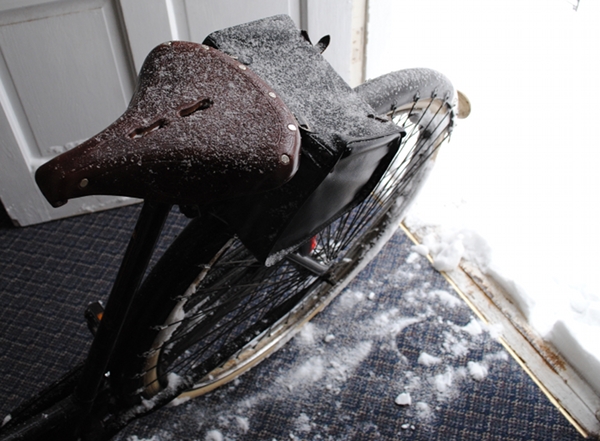 This short but beautiful winter adventure was more than enough for me and Velouria. We were happy to return to the warmth of our home - both of us trailing lots of snow. That snow on the saddle accumulated during the time it took me to drag the bicycle up the front stairs. If you don't want snow on your leather saddle, consider swapping it out for a vinyl one for the winter. For me, a little precipitation on the leather is okay though.
This short but beautiful winter adventure was more than enough for me and Velouria. We were happy to return to the warmth of our home - both of us trailing lots of snow. That snow on the saddle accumulated during the time it took me to drag the bicycle up the front stairs. If you don't want snow on your leather saddle, consider swapping it out for a vinyl one for the winter. For me, a little precipitation on the leather is okay though.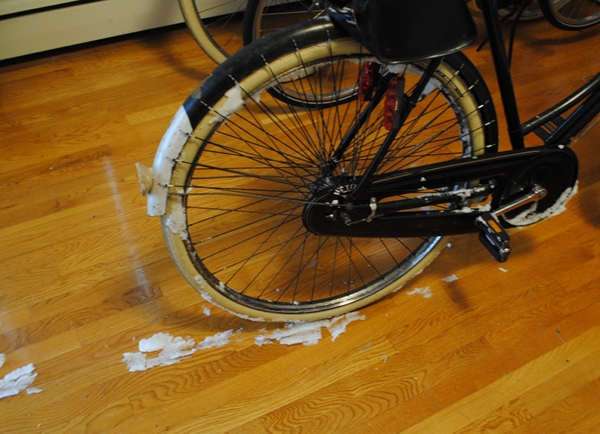 I did experience a panicked sense of remorse when I saw the extent of snow accumulation on the bicycle once we got home, and the next 30 minutes after this photo was taken were spent with a rag, frantically wiping off the moisture. I have been assured however, that the snow in itself is not bad for the bicycle; it is only the salt that is damaging. Thankfully, the roads had not been salted yet at the time of our ride. Velouria enjoyed the refreshing tour through our local Winter Wonderland. She is up for doing it all again - as long as I promise to go slowly, keeping her rod brakes in mind.
I did experience a panicked sense of remorse when I saw the extent of snow accumulation on the bicycle once we got home, and the next 30 minutes after this photo was taken were spent with a rag, frantically wiping off the moisture. I have been assured however, that the snow in itself is not bad for the bicycle; it is only the salt that is damaging. Thankfully, the roads had not been salted yet at the time of our ride. Velouria enjoyed the refreshing tour through our local Winter Wonderland. She is up for doing it all again - as long as I promise to go slowly, keeping her rod brakes in mind.
 This is the full view of the roadrunner with the horned toad climbing up the tree truck.
This is the full view of the roadrunner with the horned toad climbing up the tree truck.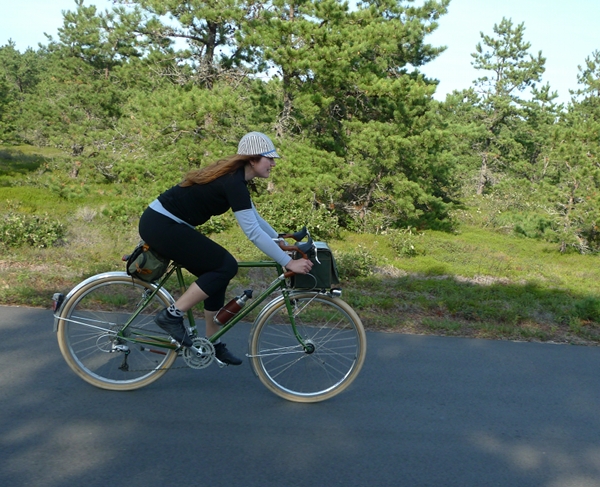 Upon returning to the city and getting on my Gazelle again, I was surprised by how different the cycling experience felt from being on my Rivendell.
Upon returning to the city and getting on my Gazelle again, I was surprised by how different the cycling experience felt from being on my Rivendell. Normally, I ride both bicycles regularly, so the switch back and forth does not feel remarkable. But after having cycled solely on a roadbike for three weeks, I almost felt as if I had to forcefully uncurl my spine as I transformed from a quadruped to a biped.
Normally, I ride both bicycles regularly, so the switch back and forth does not feel remarkable. But after having cycled solely on a roadbike for three weeks, I almost felt as if I had to forcefully uncurl my spine as I transformed from a quadruped to a biped.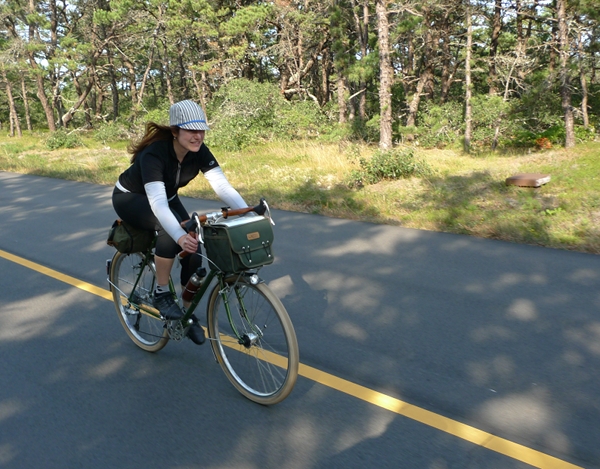 While we were away, the Co-Habitant teased that I would get accustomed to using a roadbike for transportation and would probably just keep doing it when we got home - after all, it's faster. But it soon became clear that when it comes to upright bicycles, absence made the heart grow fonder. (Now, if I can just stop trying to use the non-existent bar-end shifters on my poor Dutch bike!)
While we were away, the Co-Habitant teased that I would get accustomed to using a roadbike for transportation and would probably just keep doing it when we got home - after all, it's faster. But it soon became clear that when it comes to upright bicycles, absence made the heart grow fonder. (Now, if I can just stop trying to use the non-existent bar-end shifters on my poor Dutch bike!) I think that as upright mammals, we are accustomed to seeing the world from the vantage point of bipedalism and we feel the most relaxed when adopting that posture.It is only natural that people prefer to remain upright when moving through their environment - whether on foot, or on bike, or on public transport. While upright bicycles may not be appropriate for sport or long distance travel, their importance in the realm of "normal cycling" cannot be overstated. Most people considering a bicycle for transportation do not see themselves as "cyclists". They want to be their usual selves, except on a bike. I think the ability to remain an upright mammal is crucial to retaining one's inherent sense of self while cycling for transportation.
I think that as upright mammals, we are accustomed to seeing the world from the vantage point of bipedalism and we feel the most relaxed when adopting that posture.It is only natural that people prefer to remain upright when moving through their environment - whether on foot, or on bike, or on public transport. While upright bicycles may not be appropriate for sport or long distance travel, their importance in the realm of "normal cycling" cannot be overstated. Most people considering a bicycle for transportation do not see themselves as "cyclists". They want to be their usual selves, except on a bike. I think the ability to remain an upright mammal is crucial to retaining one's inherent sense of self while cycling for transportation.



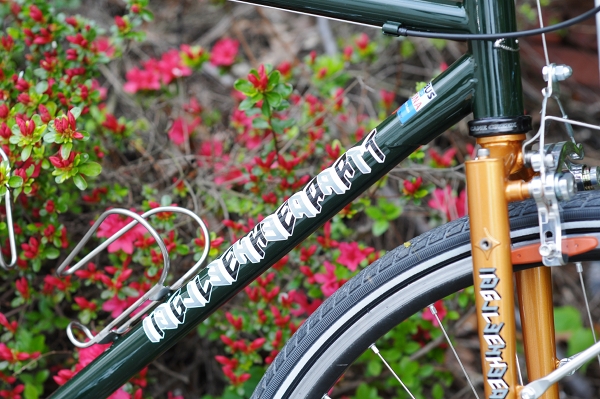 At the New England Bicycle Expoa couple of weekends ago, I had the pleasure of meeting legendary New England framebuilder Christopher Igleheart and briefly test riding one of his bicycles - an upright commuter model called the Yoyodyne. One cool thing about this bike - aside from it being an Igleheart - was the3-speed Sturmey Archer S3X hub - aka "the sex hub." Several people I know have set up their bikes with this hub and their feedback has been intriguing, so I wanted to try for myself. And what better way than on an Igleheart bike?
At the New England Bicycle Expoa couple of weekends ago, I had the pleasure of meeting legendary New England framebuilder Christopher Igleheart and briefly test riding one of his bicycles - an upright commuter model called the Yoyodyne. One cool thing about this bike - aside from it being an Igleheart - was the3-speed Sturmey Archer S3X hub - aka "the sex hub." Several people I know have set up their bikes with this hub and their feedback has been intriguing, so I wanted to try for myself. And what better way than on an Igleheart bike? Located just North of Boston, Mr. Igleheart - like many local builders - traces his professional beginnings to the legacy of Fat City Cycles, where he started as an apprentice welder in the 1980s. By 1994 he had established Igleheart Custom Frames as an independent operation, spcialising in TIG-welded steel. In the chaotic environment of the Bicycle Expo, a sense of calm presided over the crowded Igleheart booth. The man is very comfortable with his work and discusses it in a way that communicates his experience and versatility. Road bikes, mountain bikes, transportation bikes and even randonneuring bikes - he knows them all, executing them in his distinct aesthetic.
Located just North of Boston, Mr. Igleheart - like many local builders - traces his professional beginnings to the legacy of Fat City Cycles, where he started as an apprentice welder in the 1980s. By 1994 he had established Igleheart Custom Frames as an independent operation, spcialising in TIG-welded steel. In the chaotic environment of the Bicycle Expo, a sense of calm presided over the crowded Igleheart booth. The man is very comfortable with his work and discusses it in a way that communicates his experience and versatility. Road bikes, mountain bikes, transportation bikes and even randonneuring bikes - he knows them all, executing them in his distinct aesthetic.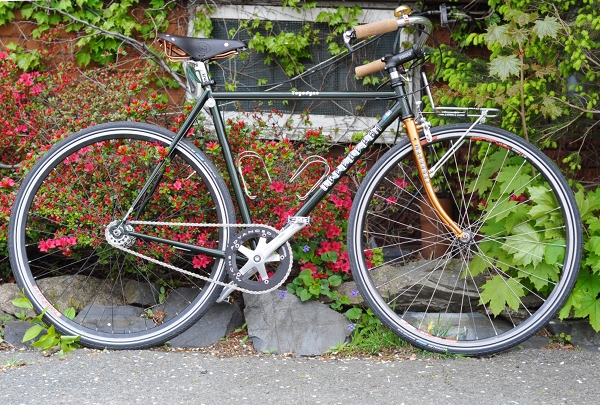 Unfortunately, I somewhat dropped the ball on photographing this beautiful bicycle. The high noon light was unflattering from every angle, the background I chose was too busy, and people kept coming up to ask about the bike and distracting me. The results are washed out and entirely unworthy of the Yoyodyne, so I did what I usually do with ruined pictures: upped the contrast and at least tried to make them atmospherically interesting.
Unfortunately, I somewhat dropped the ball on photographing this beautiful bicycle. The high noon light was unflattering from every angle, the background I chose was too busy, and people kept coming up to ask about the bike and distracting me. The results are washed out and entirely unworthy of the Yoyodyne, so I did what I usually do with ruined pictures: upped the contrast and at least tried to make them atmospherically interesting. 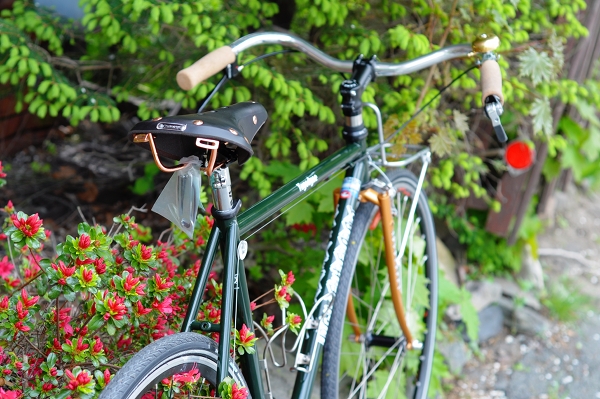 The Yoyodyne is designed as a fun and comfortable city bike. This particular one has a green frame and an orange fork, which is an unexpectedly pleasing colour combination.
The Yoyodyne is designed as a fun and comfortable city bike. This particular one has a green frame and an orange fork, which is an unexpectedly pleasing colour combination. ColumbusZona is a comfortable all-around tubing that contributes to a plush ride quality. The welds are very cleanly done. The segmented fork is one of my favourite fork designs and I never tire of its various iterations from different New England framebuilders.
ColumbusZona is a comfortable all-around tubing that contributes to a plush ride quality. The welds are very cleanly done. The segmented fork is one of my favourite fork designs and I never tire of its various iterations from different New England framebuilders. Components cater to urban commuting, combining good quality and budget considerations: single crankset,Soma stem and Oxford swept-back handlebars, cork grips, simple city brake lever, brass bell, and a front rack. [edited to add: I just learned that the price for this complete bicycle is $1900 - good deal!]
Components cater to urban commuting, combining good quality and budget considerations: single crankset,Soma stem and Oxford swept-back handlebars, cork grips, simple city brake lever, brass bell, and a front rack. [edited to add: I just learned that the price for this complete bicycle is $1900 - good deal!] Cardiff leather saddle with copper rivets. You can't see this very well here, but the seat post has a special feature that allows the top of it to be easily detached and reattached, without having to re-adjust saddle position.
Cardiff leather saddle with copper rivets. You can't see this very well here, but the seat post has a special feature that allows the top of it to be easily detached and reattached, without having to re-adjust saddle position. And of course, the exciting 3-speed fixed gear hub. A testament to just how distracted I was, I even failed to capture the "S3X" label. It's on the other side.
And of course, the exciting 3-speed fixed gear hub. A testament to just how distracted I was, I even failed to capture the "S3X" label. It's on the other side.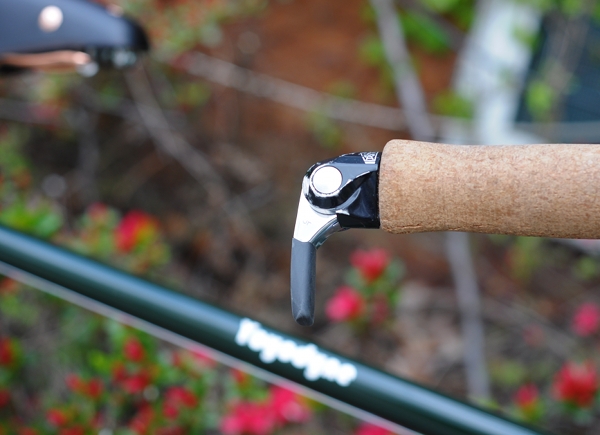 Sturmey Archerhas a new gear shifter for 3 and 5-speed hubs that is versatile in that it can be used both on upright and drop handlebars. I found it a little difficult to budge in comparison to the traditional trigger shifter, but perhaps that can be adjusted.
Sturmey Archerhas a new gear shifter for 3 and 5-speed hubs that is versatile in that it can be used both on upright and drop handlebars. I found it a little difficult to budge in comparison to the traditional trigger shifter, but perhaps that can be adjusted.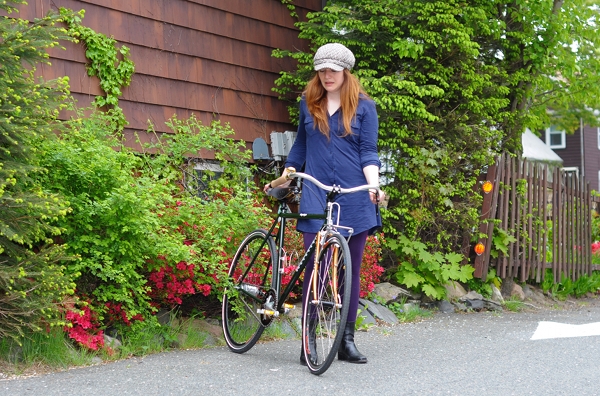 It's difficult to properly test ride a bicycle at a crowded Bike Expo, but I made a half dozen laps on it around the large parking lot in the back of the building, as well as cycled up and down the long driveway a few times. With a constant stream of cars coming and going it was like a slower version of actual urban cycling.
It's difficult to properly test ride a bicycle at a crowded Bike Expo, but I made a half dozen laps on it around the large parking lot in the back of the building, as well as cycled up and down the long driveway a few times. With a constant stream of cars coming and going it was like a slower version of actual urban cycling. The ride with the S3X hub felt interesting, but I would say not entirely like a fixed gear bike. When I ride a single speed fixed gear, there is more to the sensation than merely not coasting. I feel like I have a direct connection to the drivetrain, and for me that is part of what makes riding fixed gear bikes enjoyable. This aspect is gone with the S3X: It basically feels like a nice 3-speed hub that does not allow you to coast. Shifting is easy and the gear spacing is just about perfect, but no matter what gear it is in, the feeling is not quite the same as single speed fixed gear.
The ride with the S3X hub felt interesting, but I would say not entirely like a fixed gear bike. When I ride a single speed fixed gear, there is more to the sensation than merely not coasting. I feel like I have a direct connection to the drivetrain, and for me that is part of what makes riding fixed gear bikes enjoyable. This aspect is gone with the S3X: It basically feels like a nice 3-speed hub that does not allow you to coast. Shifting is easy and the gear spacing is just about perfect, but no matter what gear it is in, the feeling is not quite the same as single speed fixed gear.
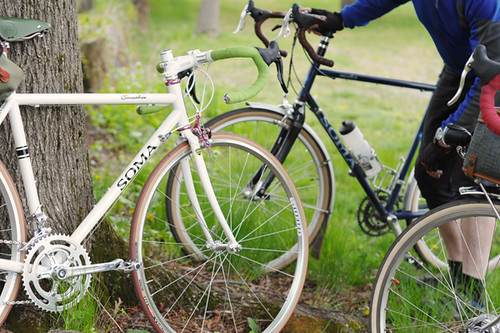
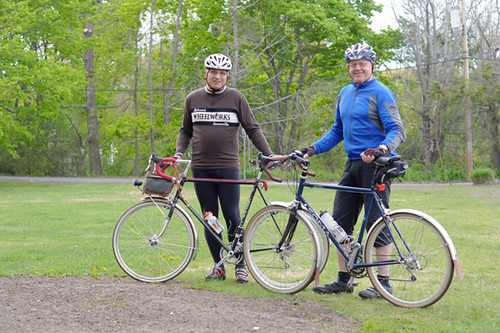
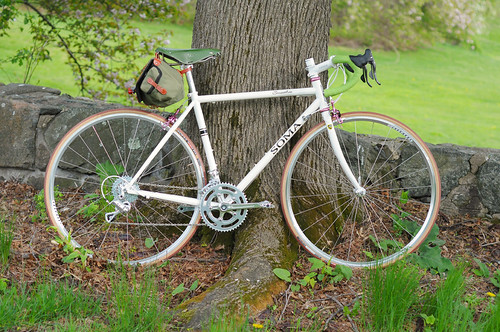
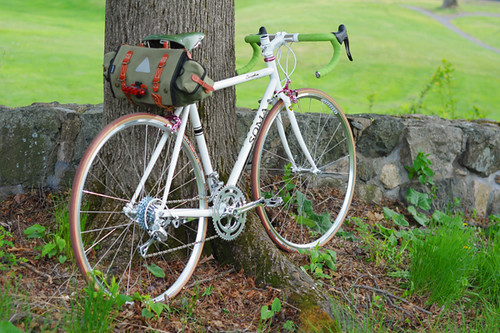




 Last summer I wrote a post calledCycling Clothes for the Lycra-Averse, in which I explained my inability to wear synthetic fabrics (including lycra) and described my alternatives for sporty rides. These included leggings, gauzy tops and breezy mini-dresses made of natural fabrics. Those outfits worked for the gently paced and mostly flat 20 mile rides I did at the time. But this year, as my rides grew longer and more intense, these outfits soon became unsuitable. At this point I feel that I need proper cycling clothes, and here is why:
Last summer I wrote a post calledCycling Clothes for the Lycra-Averse, in which I explained my inability to wear synthetic fabrics (including lycra) and described my alternatives for sporty rides. These included leggings, gauzy tops and breezy mini-dresses made of natural fabrics. Those outfits worked for the gently paced and mostly flat 20 mile rides I did at the time. But this year, as my rides grew longer and more intense, these outfits soon became unsuitable. At this point I feel that I need proper cycling clothes, and here is why: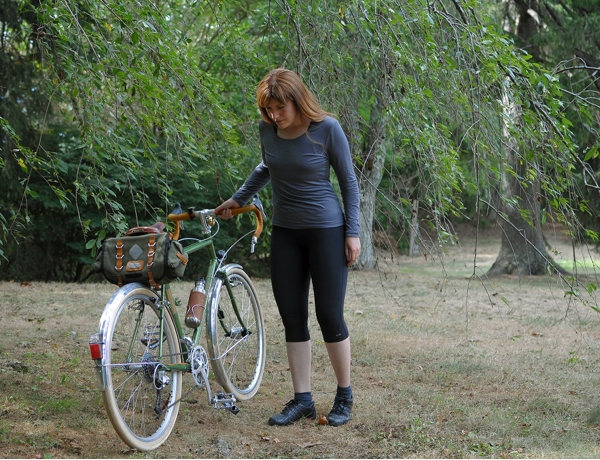 In short, I understand that tight, seamless, moisture-wicking lycra cycling clothing were created for a reason. But while I understand that, I still cannot wear it due to my skin's rejection of synthetic fabrics (before anybody asks, I did give it a try). Many have suggested wool as an alternative, but after having already spent money on the lycra, I needed to recover and save up before giving the wool stuff a try. Last time I tried to wear wool next to my skin, it felt itchy and the memory of that is still strong. I am told the new merino is different, and I am slowly working up to believing that. In the meantime, my solution has been silk tops, and partly synthetic running tights.
In short, I understand that tight, seamless, moisture-wicking lycra cycling clothing were created for a reason. But while I understand that, I still cannot wear it due to my skin's rejection of synthetic fabrics (before anybody asks, I did give it a try). Many have suggested wool as an alternative, but after having already spent money on the lycra, I needed to recover and save up before giving the wool stuff a try. Last time I tried to wear wool next to my skin, it felt itchy and the memory of that is still strong. I am told the new merino is different, and I am slowly working up to believing that. In the meantime, my solution has been silk tops, and partly synthetic running tights.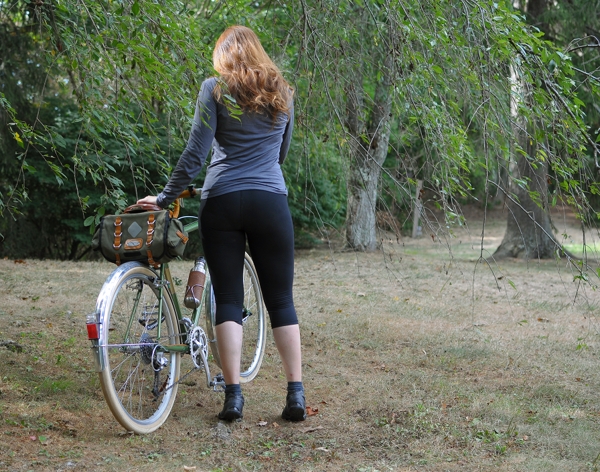 Silk has similar temperature regulating and moisture wicking properties as wool, and it dries almost instantly when you sweat. I have several long sleeve silk tees, as well as a silk sports-bra (from Wintersilks), and that is what I've been wearing. When we think of silk, we tend to imagine a slippery satiny material, but in actuality it exists in "normal" textures as well. The top I am wearing here feels like a jersey-knit long-sleeve tee. It has been great in the oppressive heat and humidity so far, and it almost does not flutter. The bottoms are Champion leggings designed for running. They are made from a cotton-spandex-lycra mix that is not quite as bad against my skin as 100% lycra, but still has wicking properties and, most importantly a seamless placket around the crotch. The placket is not as large as I would ideally like, but it's been all right for now.
Silk has similar temperature regulating and moisture wicking properties as wool, and it dries almost instantly when you sweat. I have several long sleeve silk tees, as well as a silk sports-bra (from Wintersilks), and that is what I've been wearing. When we think of silk, we tend to imagine a slippery satiny material, but in actuality it exists in "normal" textures as well. The top I am wearing here feels like a jersey-knit long-sleeve tee. It has been great in the oppressive heat and humidity so far, and it almost does not flutter. The bottoms are Champion leggings designed for running. They are made from a cotton-spandex-lycra mix that is not quite as bad against my skin as 100% lycra, but still has wicking properties and, most importantly a seamless placket around the crotch. The placket is not as large as I would ideally like, but it's been all right for now.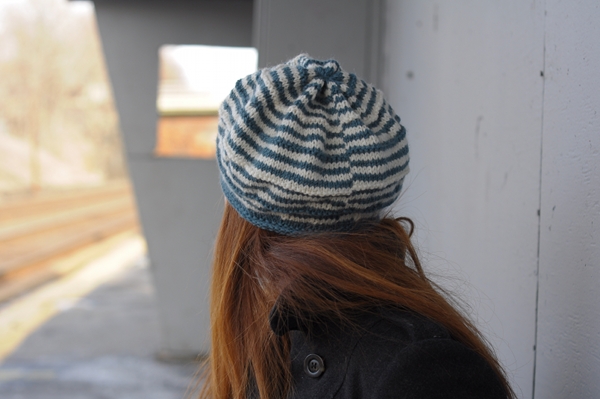 It has been two and a half months now without the car - pretty much the entire winter. For the most part we did not miss it. But now that the blizzards have subsided, it is time to get things done. We'll start going on photoshoots and other trips again soon, and there are other ways in which we will need it as well. This weekend was our first experiment with alternative options.
It has been two and a half months now without the car - pretty much the entire winter. For the most part we did not miss it. But now that the blizzards have subsided, it is time to get things done. We'll start going on photoshoots and other trips again soon, and there are other ways in which we will need it as well. This weekend was our first experiment with alternative options. After getting done everything that we needed done, we had several hours to kill before heading back. The Saturday train schedule limited our choice for when to travel considerably: There was basically one train in the early afternoon and another late at night. So we test rode some Moultons and wandered around the three shops on the Main street, beforeheading for the Commuter Rail station.
After getting done everything that we needed done, we had several hours to kill before heading back. The Saturday train schedule limited our choice for when to travel considerably: There was basically one train in the early afternoon and another late at night. So we test rode some Moultons and wandered around the three shops on the Main street, beforeheading for the Commuter Rail station.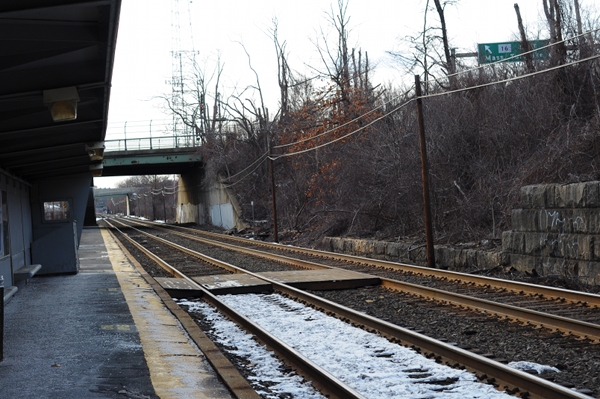 We arrived several minutes early. The station is outdoors and the train was 7 minutes late. In freezing temperatures, that wait is more difficult to endure than it sounds. The other people on the platform looked miserable as they paced back and forth to keep warm and cursed the train's (apparently habitual) lateness.
We arrived several minutes early. The station is outdoors and the train was 7 minutes late. In freezing temperatures, that wait is more difficult to endure than it sounds. The other people on the platform looked miserable as they paced back and forth to keep warm and cursed the train's (apparently habitual) lateness.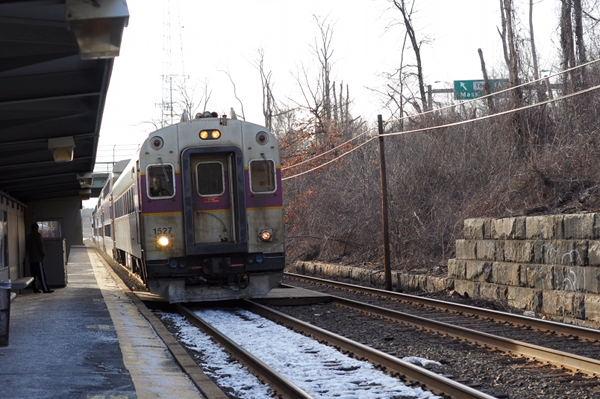 But finally it arrived, and thankfully it was warm inside. The numbness in my face began to subside as we headed toward Boston. Once in the city, we transferred to the subway, then walked home from the station.
But finally it arrived, and thankfully it was warm inside. The numbness in my face began to subside as we headed toward Boston. Once in the city, we transferred to the subway, then walked home from the station.




